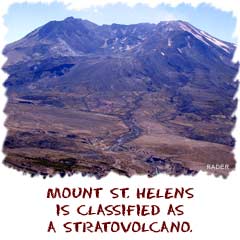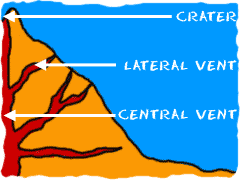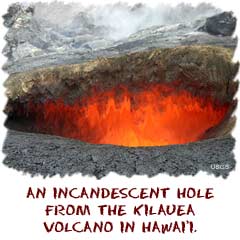Types of Volcanoes
 There are two main types of volcanoes: shield and composite. Shield volcanoes are usually found in the middle of tectonic plates. Islands like Hawai'i are good examples of this type of volcano. There's a hole in the middle of the plate and magma moves out and piles on top of itself, slowly building a mountain of rock. That magma comes from small tunnels which scientists call vents.
There are two main types of volcanoes: shield and composite. Shield volcanoes are usually found in the middle of tectonic plates. Islands like Hawai'i are good examples of this type of volcano. There's a hole in the middle of the plate and magma moves out and piles on top of itself, slowly building a mountain of rock. That magma comes from small tunnels which scientists call vents.
The other big type is a composite volcano. This type of volcano is usually what you think of as a volcano. It's shaped like a cone and mainly made up of ash, which has piled up and compacted over the years. You'd find these volcanoes in subduction zones like Mount Ararat in Turkey. The stuff that comes out is smaller. There's not so much lava but lots of small rocks and a lot of ash. Those rocks are called pyroclastic.

Structure Basics
We'll start at the bottom when we look at the structure of a volcano. All of the molten rock in the asthenosphere finds weaknesses in the crust. The molten rock creates a main passageway called a central vent. As the magma rises, secondary vents develop. Those secondary ones are just smaller and branch from the main tube. At the top of the volcano, at its highest point, is a crater. Some volcanoes have something called a caldera. A caldera forms when a volcano gets hollow and then collapses on itself. A caldera could look like a large indentation on the side of the volcano or it could happen at the very top.Lava Movement
We already told you about the parts of a volcano. You must be wondering what happens with the lava. How does it get to the surface? All of the magma is created in the asthenosphere. The asthenosphere is the layer of molten rock just beneath the continental plates. The magma slowly rises through the lithosphere. It rises because it's hot and because of the increased pressure below. The magma slowly moves up the vents. Eventually passages called diapers are created. And behold! The lava flows from the volcano!
Types of Lava
Just as there are multiple types of volcanoes, there are three types of lava. Silicic lava you should be able to figure out. Have you ever heard of the element silicon? Silicon is the main component of silicic lava. It's 70 percent silicon dioxide compounds. That type of lava has formed most of the continents.The second type is mafic lava. It has the least amount of silicon dioxide compounds, less than 50 percent. It has a lot of iron and manganese compounds to make up the difference. It makes up most of the rock at the bottom of the ocean.
Last, but not least, is intermediate lava. It's in the middle in more ways than one. It has percentages of silicon substances in between silicic and mafic lava types. It is also the type of rock that makes up the edges of the continents (between the ocean floors and main continental plates). It's like the middle kid in the family.
Or search the sites for a specific topic.
- Overview
- Composition
- Magnetic Field
- Structure
- Rock Types
- Tectonics
- Faulting
- Earthquakes
- Volcanoes
- More Topics

Volcano Web Shorts: Debris Flows (USGS Video)

Useful Reference Materials
Encyclopedia.com:http://www.encyclopedia.com/topic/Volcanoes.aspx
Wikipedia:
http://en.wikipedia.org/wiki/Volcano
Encyclopædia Britannica:
http://www.britannica.com/EBchecked/topic/632130/volcano





